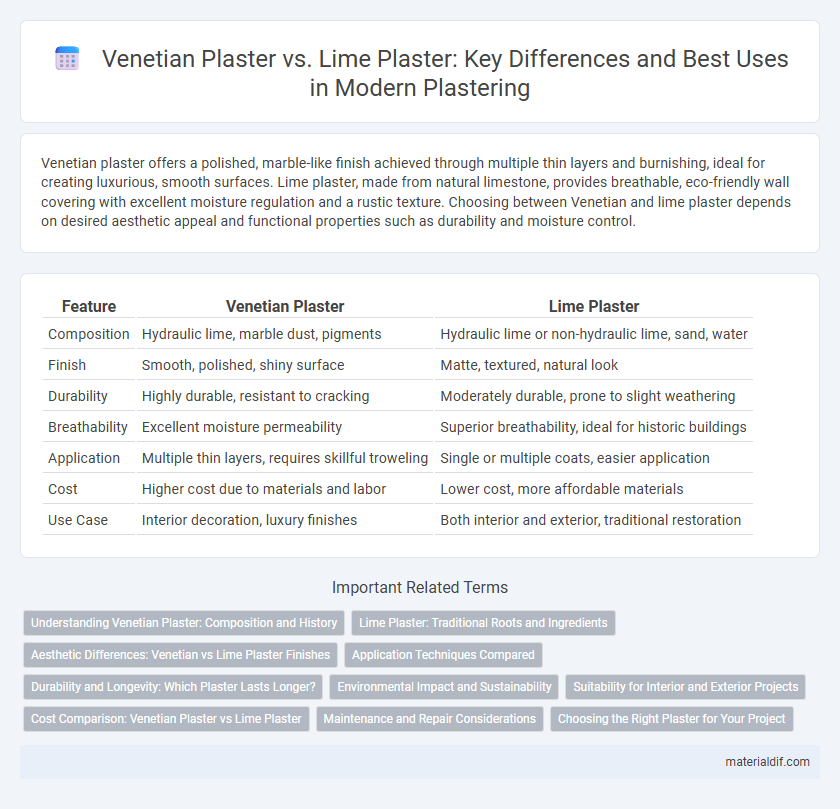Venetian plaster offers a polished, marble-like finish achieved through multiple thin layers and burnishing, ideal for creating luxurious, smooth surfaces. Lime plaster, made from natural limestone, provides breathable, eco-friendly wall covering with excellent moisture regulation and a rustic texture. Choosing between Venetian and lime plaster depends on desired aesthetic appeal and functional properties such as durability and moisture control.
Table of Comparison
| Feature | Venetian Plaster | Lime Plaster |
|---|---|---|
| Composition | Hydraulic lime, marble dust, pigments | Hydraulic lime or non-hydraulic lime, sand, water |
| Finish | Smooth, polished, shiny surface | Matte, textured, natural look |
| Durability | Highly durable, resistant to cracking | Moderately durable, prone to slight weathering |
| Breathability | Excellent moisture permeability | Superior breathability, ideal for historic buildings |
| Application | Multiple thin layers, requires skillful troweling | Single or multiple coats, easier application |
| Cost | Higher cost due to materials and labor | Lower cost, more affordable materials |
| Use Case | Interior decoration, luxury finishes | Both interior and exterior, traditional restoration |
Understanding Venetian Plaster: Composition and History
Venetian plaster is a decorative wall finish composed primarily of slaked lime and marble dust, renowned for its smooth, polished surface and subtle sheen. Originating in ancient Rome and perfected during the Renaissance, it combines artistic craftsmanship with durable materials to create elegant, breathable interiors. This plaster's unique composition allows it to age gracefully, developing a natural patina that enhances historic and modern architectural spaces.
Lime Plaster: Traditional Roots and Ingredients
Lime plaster, composed primarily of slaked lime, sand, and water, boasts ancient origins dating back thousands of years, widely used in Mediterranean architecture for its natural breathability and moisture regulation properties. This plaster's traditional formulation allows walls to flex and cure slowly, reducing cracks and enhancing durability in historic buildings. Compared to Venetian plaster, lime plaster lacks the polished sheen but offers superior ecological benefits and compatibility with older masonry materials.
Aesthetic Differences: Venetian vs Lime Plaster Finishes
Venetian plaster offers a polished, glossy finish with a smooth, marble-like appearance that enhances interior walls with depth and richness. Lime plaster provides a matte, textured surface that emphasizes natural, rustic charm and breathability, suitable for historic or eco-friendly designs. The aesthetic choice between Venetian and lime plaster hinges on the desired look--luxurious sheen versus organic patina.
Application Techniques Compared
Venetian plaster requires multiple thin layers applied with a trowel, followed by careful burnishing to create a smooth, glossy finish, emphasizing a polished marble effect. Lime plaster demands a coarser application with broader strokes, often involving traditional hand troweling and natural drying to achieve breathable, textured walls. Both techniques demand skill but Venetian plaster focuses on fine detailing and sheen, while lime plaster prioritizes natural patina and durability in humid environments.
Durability and Longevity: Which Plaster Lasts Longer?
Venetian plaster, made from lime putty and marble dust, provides a highly durable and moisture-resistant finish that can last decades with proper maintenance. Lime plaster, composed primarily of lime and sand, offers excellent breathability and flexibility but tends to be more susceptible to weathering and erosion over time. When comparing longevity, Venetian plaster generally outperforms lime plaster in terms of durability, especially in high-traffic or moisture-prone environments.
Environmental Impact and Sustainability
Venetian plaster, made primarily from natural lime and marble dust, offers a sustainable finish due to its non-toxic composition and durability which reduces the need for frequent replacements, minimizing waste. Lime plaster, composed of slaked lime and sand, is highly breathable and biodegradable, promoting healthier indoor air quality and lower environmental impact during production. Both materials are eco-friendly choices that support sustainability through natural ingredients, low VOC emissions, and the ability to be recycled or safely returned to the environment.
Suitability for Interior and Exterior Projects
Venetian plaster offers a polished, marble-like finish ideal for sophisticated interior walls due to its smooth texture and durability in controlled environments. Lime plaster, known for its breathability and natural resistance to moisture and mold, excels in both interior and exterior applications, particularly in historic restorations and exterior facades where weather resistance is crucial. Choosing between them depends on project requirements: Venetian plaster suits decorative indoor surfaces, while lime plaster provides functional protection for exterior walls and breathable interiors.
Cost Comparison: Venetian Plaster vs Lime Plaster
Venetian plaster typically costs between $70 and $90 per square foot due to its labor-intensive application and premium materials, while lime plaster averages around $5 to $10 per square foot, making it a more economical choice. The higher cost of Venetian plaster reflects its polished, marble-like finish and durability, which often reduces long-term maintenance expenses. Lime plaster offers breathability and natural antimicrobial properties, providing cost-effective benefits despite its simpler aesthetic.
Maintenance and Repair Considerations
Venetian plaster requires regular sealing to maintain its glossy finish and prevent moisture damage, with minor scratches often remedied through buffing or reapplication of a thin glaze. Lime plaster, being more porous, allows natural breathability but demands careful patching with compatible lime-based materials to avoid cracking or color mismatches. Both finishes benefit from routine inspections to address wear, but lime plaster's flexibility offers superior durability in historic or moisture-prone environments.
Choosing the Right Plaster for Your Project
Venetian plaster offers a polished, marble-like finish ideal for luxury interiors, while lime plaster provides breathability and durability suited for historic restoration and eco-friendly builds. Selecting between Venetian and lime plaster depends on project requirements such as desired aesthetics, moisture control, and surface longevity. Understanding the substrate, climate conditions, and maintenance needs ensures the right plaster choice for long-lasting, visually appealing results.
Venetian Plaster vs Lime Plaster Infographic

 materialdif.com
materialdif.com